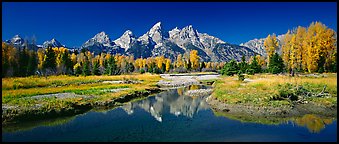 |
| One of the geysers in Yellowstone National Park |
Of all the national parks, Yellowstone stands out in my
mind, probably because it is so unusual.
The landscape is like nothing else on this earth. In places it is like a moonscape, and in
other places it is trees and rivers and beautiful. There are geysers everywhere, and some of
them are sulphur, so they can be smelly. It is very diverse landscape, and one of the most interesting places to visit.
 |
| Elk Horn Arch in Jackson, Wyoming |
Then we headed north, which took us through Grand Teton National Park. We actually headed into that park in the morning and spent the whole day wandering through the park, only exiting and heading onto Yellowstone in the evening, because we had reservations for the night at the Old Faithful cabins.
If you don't want to drive all the way from where you live then you could fly to Salt Lake City (which is the closest hub and therefore probably the least expensive place to fly to) and rent a car. From there you can drive all the way to Yellowstone in one day, but if you want to see Jackson and the Grand Tetons then an overnight in that area would be a good idea.
 |
| The Grand Tetons |
The central feature of the park is the Teton Range, a 40-mile long mountain front rising from the valley floor some 6,000 feet. The jagged range includes its signature peak Grand Teton at 13,770 feet and at least twelve pinnacles over 12,000 feet. Seven lakes adorn the base of the range, and more than 100 alpine lakes dot the backcountry. Elk, moose, mule deer, bison and pronghorn are commonly found in the park. Black bears roam the forests and canyons, while grizzlies wander throughout more remote portions of the park. More than 300 species of birds can be observed including bald eagles, peregrine falcons and trumpeter swans.
 |
| Jenny Lake in the the Grand Teton National Park |
There are many outdoor recreation activities to choose from
at Grand Teton National Park. During the summer you can hike, walk, view wildlife,
take photographs, backpack, camp, climb, fish, swim, boat, float, canoe and
bike. In winter skiing and snowshoeing are popular activities.
There are 4 visitor centers and well as an information
center. There are several lodges where
you can stay, several areas have cabins for rent and there are 6 campgrounds
within the park. Dogs are allowed in the park as long as they are leashed, but they are not allowed on many of the trails. There are entrance
fees, and they are basic to what other national parks charge, and they allow for
multiple days. I have talked about the
annual passes and the military and senior passes in other posts. If you have want more details about the fees,
go to http://www.nps.gov/grte/planyourvisit/feesandreservations.htm
The distance from the north edge of Grand Teton National
Park to the south entrance of Yellowstone National Park is 6.6 miles. So if you are doing either of these parks,
they are a natural to combine them and see both in one trip.
 |
| Geyser in Yellowstone National Park |
 |
| Yellowstone Falls |
Visitors wishing to visit the park on a snowmobile or in a
snowcoach must either travel by commercial snowcoach or accompany a commercial
guide on snowmobiles (private, unguided snowmobiles or snowcoaches are not
allowed). Best Available Technology snowmobiles are required, and there is a
daily limit on snowmobile and snowcoach entries. Off-road use of snowmobiles
and snowcoaches is prohibited.
There are 8 visitor centers in the park as well as every
kind of service you will need. There are
numerous lodges and cabins to rent, as well as many campgrounds. There are stores to purchase food and
supplies, and restaurants at all of the lodges.
There are gas stations, boat rental places, horseback riding and llama
backpacking trips that can be booked.
 |
| On the road with Natasha |
 |
| Buffalo in Yellowstone NP |
Bear in Yellowstone NP
|
You will certainly see some wildlife there also. We saw quite a few different animals while
there. Besides the buffalo mentioned
above, we also saw deer, elk and coyotes, as well as many different kinds of
birds. Bears are quite often spotted. For safety you should stay away from the wild
animals. It is important to stay on the marked paths. Yellowstone's thermal
features, rare among the earth's wonders, are extremely fragile. Boardwalks and
trails protect you and preserve delicate formations. Scalding water underlies
most of the thin, breakable crust. Pools may be near or above the boiling
temperature and can cause severe, possibly even fatal, burns.
For more information about Yellowstone National Park, the fees, lodging and campgrounds, and how to make reservations for those (which is important as the park is booked well in advance), go to: http://www.nps.gov/yell/index.htm
 |
| We also saw some elk in the park |

No comments:
Post a Comment